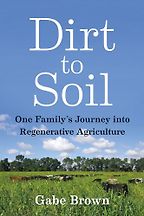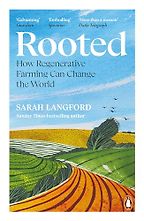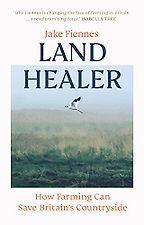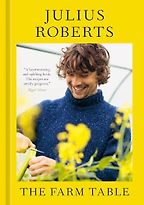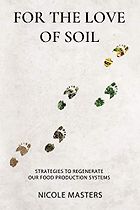You’ve chosen the best books on regenerative agriculture. Before we look at them in detail, perhaps you’d talk us through the concept first, and explain how it differs from more traditional farming. What are the problems that regenerative agriculture is trying to solve?
Well, I’d say that in fact it is a return to traditional agriculture. In the past farming depended on how well you looked after the soil. A crop removes nutrients from the soil every time you harvest plants, so you have to replace those with manure or green waste. The chemical revolution after the Second World War removed that emphasis. All of a sudden it was okay to deplete the soil, because you could just keep on adding what your crop needed with artificial fertilisers. This seemed like a good idea at the time, and indeed it did help feed a lot of hungry people, but it caused all sorts of problem.
Farms became reliant on artificial fertilisers created with fossil fuels and the soil itself became so poor in many areas it became a desert. Regenerative agriculture argues that farming needs to return to the central tenant that the first principle is to not just to look after the soil, but ‘regenerate’ the soil after every crop.
I am from a farming family. My great grandfather spread ‘night soil’ (that is, sewage from Edinburgh) on his crops in East Lothian in Scotland. My father was a product of his time and used artificial nitrogen on his crops. Now my brother is looking at sewage once again albeit in a highly-treated granulated form in order to try to ‘regenerate the soil’.
Regenerative agriculture does not discount using chemicals to control pests, but only as a last resort because chemicals themselves destroy the complex ecosystem that makes healthy soil. Instead it argues that farming should regenerate the soil by returning to traditional methods such as manure and green waste, or planting trees alongside crops (agroforestry), as well as using new technologies such soil sampling to identify exactly what nutrients your soil needs and drip irrigation to retain water in the soil. It goes wider too, arguing that farming should ‘regenerate’ local communities and biodiversity.
What I find exciting about it is it is so inclusive. Big names in the farming world like James Rebanks—who wrote English Pastoral—have embraced regenerative agriculture because it enables a way of farming that continues certain traditions, such as livestock forming part of the nutrient cycle, while also protecting wildlife. It enables farmers to shift to a more environmentally friendly way of farming without necessarily compromising high yields and without going completely organic. Big brands have got on board, as well as smaller farms.
Some people might say that weakens it, but I don’t think we have time for purism in a climate crisis. Something that can feed our greedy human population without wrecking the planet is worth looking at.
Shall we talk about soil and the nutrient cycle first? Your first book is For the Love of Soil: Strategies to Regenerate Our Food Production System by the American agro-ecologist Nicole Masters
To understand the power and possibility of regenerative agriculture you have to get excited by soil. And boy is Nicole Masters excited by soil! She describes life underground as ‘like something out of Alien’ with hideous creatures eating other from the inside—and it is, kind of. A single handful of soil can contain more life than the human population of Planet Earth.
This complex ecosystem can easily be knocked off balance by artificial chemicals, but equally, with the right care, it can regenerate easily. Masters has dedicated her life to helping farmers understand their own soil. She travels the world explaining to farmers how to ditch the plough and instead pick up the spade to understand the soil beneath their feet. She has been described to me by one—very sensible—farmer as a ‘soil goddess’.
In this book she not only tells the story of how farms can regenerate the soil but how she herself recovered from ‘chemical toxification’ and how we can recover human health more widely through growing food in healthy soils.
Your second book recommendation is told from the perspective of an old-school farmer who switched to regenerative methods on his family farm in North Dakota. Would you talk us through From Dirt to Soil by Gabe Brown—and explain the difference?
You could not get a more typical Midwestern farmer than Gabe Brown. He loves his family, he loves his country and he loves his God. But as a conventional farmer he was struggling. Year after year, his crops were failing and he was struggling to keep the farm afloat. He took the very brave and—to his neighbours—crazy decision to switch to regenerative agriculture.
They practice ‘no-till’ farming, which reduces soil erosion, and use as few fertilisers and herbicides as possible. It sounds like it was quite a learning curve.
It was not an easy decision, he came close to bankruptcy many times, but gradually as his soils recovered, he noticed his crops were able to survive the changing climate. Brown became an advocate for regenerative agriculture, appearing in the Netflix documentary Kiss the Ground, which is narrated by Hollywood A-lister Woody Harrelson. His farm Brown’s Ranch now has its own brand, Nourished by Nature, selling pasture-fed meat and eggs.
“Regenerative agriculture argues that the first principle is to not just to look after the soil, but ‘regenerate’ the soil after every crop”
The power of this book is it rings true for ordinary farmers who would be put off by a ‘hippy environmentalist’ telling them what to do. Brown is an ordinary farmer, he’s one of them. He does not pull his punches in telling how hard it is to make the transition, but ultimately argues it is a necessary one.
Your third book, Rooted: Stories of Life, Land and a Farming Revolution by Sarah Langford, concentrates on how farmers in the United Kingdom are embracing the movement.
I found it refreshing to read a book about regenerative agriculture by an outsider and a woman. Langford does have farming in her background but her early professional life was in criminal and family law. She wrote In Your Defence: True Stories of Life and Law about her time as a criminal barrister in London.
She brings the same critical approach to farming life when she finds herself in the countryside running a farm alongside her husband. In one scene, she describes how she had read up on the science of agroforestry and tries to share her enthusiasm with a conventional agronomist only to feel dismissed and ridiculous for bringing up ‘kooky’ ideas. I know that feeling. Farming can be a closed world and I am grateful for her for suggesting, quietly and powerfully, that there could be another way.
Your fourth book recommendation, Land Healer by Jake Fiennes, demonstrates that regenerative agriculture and reverting to traditional farming methods can help biodiversity recover on agricultural land.
With regeneration of the soil comes the return of wildlife. Jake Fiennes is a gamekeeper turned conservation manager who has overseen the return of species like grey partridge, lapwing and yellowhammer to English farms. He also happens to be the twin brother of the actor Joseph Fiennes and brother of Ralph Fiennes.
I must admit I enjoyed the passages about early life in this bohemian somewhat unconventional family. But you cannot deny Fiennes has earned his stripes. As a young gamekeeper he trapped and killed animals as part of ‘pest control’ but as he grew up and tried different methods such as planting cover crops to provide food for birds over the winter months, he realised there were ways to boost wildlife. He argues that regenerative agriculture needs a diverse farm to cut down on chemicals and keep the soil healthy, and with that comes more wildlife.
Fiennes is open about the fact he now works for very wealthy landowners but he makes the case for a kind of farming—with hedgerows and wildflower strips—that can be introduced on highly commercial operations without losing money. Fiennes is also open about his dyslexia and the help he got to write this book, which I do not think diminishes his work. Like Gabe Brown, he’s the kind of person that farmers and land managers trust to tell a true story.
Finally, you’ve selected a cookbook: The Farm Table by Julius Roberts. Why?
The beauty of this book—and it is beautiful—is it celebrates the produce of regenerative agriculture: what we eat. First generation farmer and chef Julius Roberts makes light of the fact he is farming in a regenerative way on his farm in Dorset. He lets the food do the talking, the crunchy apples in autumn, pink rhubarb in winter and pasture-fed lamb in spring.
His message is clear, looking after the soil can result in great tasting food. With over a million followers on social media, he is a voice who can really engage young people with the potential of regenerative agriculture.
Interview by Cal Flyn, Deputy Editor
July 31, 2024. Updated: August 6, 2024
Five Books aims to keep its book recommendations and interviews up to date. If you are the interviewee and would like to update your choice of books (or even just what you say about them) please email us at [email protected]
Five Books interviews are expensive to produce. If you've enjoyed this interview, please support us by donating a small amount.

